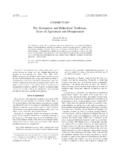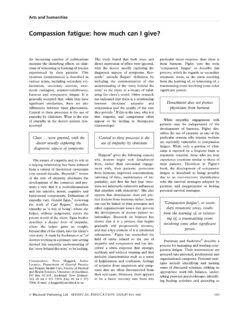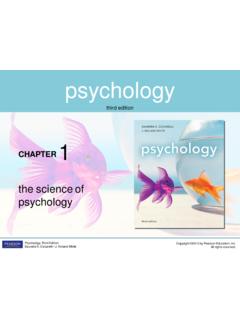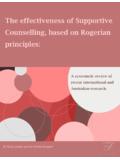Transcription of A GUIDE TO HUMANISTIC PSYCHOLOGY - …
1 UK Association of HumanisticPsychology PractitionersA GUIDE TOHUMANISTICPSYCHOLOGYby John RowanA GUIDETOHUMANISTICPSYCHOLOGY1the_guide_05 26/10/05 7:02 PM Page 1 PREFACEThe third edition of this book has been published to commemorate the 25th anniversary of the UKAssociation of HUMANISTIC PSYCHOLOGY Practitioners. The second edition was sold out a few yearsago. This compact overview of HUMANISTIC PSYCHOLOGY has proved valuable for students, trainees andpractitioners in various fields of Rowan was a founder member of AHPP and has made an immense contribution to thehumanistic approach to PSYCHOLOGY , as a writer and an active participant in the development ofpsychotherapy and counselling both in this country and abroad.
2 He is an Honorary Life Member ofUKAHPP and is still active in the field of HUMANISTIC of the original members of AHPP are still members, some retired, some moved on toother fields of work, but we owe a debt of gratitude to them for establishing professional standardsfor HUMANISTIC practitioners. Their endeavours have kept UKAHPP in the forefront in thedevelopment of psychotherapeutic practice during the past two and half decades. Our members havebeen involved in the setting up of the UK Council for Psychotherapy as well as serving on theHumanistic and Integrative Section of this body.
3 At the same time we have maintained a careful briefto ensure that HUMANISTIC principles are applied both at the ground level of practice and in the waywe carry out our work as an we welcome the publication of this book as a reminder of past achievements covering awide range of therapeutic activity as well as a celebration of the ongoing contribution of thehumanistic movement in the whole field of personal and professional 26/10/05 7:02 PM Page 2A GUIDE TO HUMANISTIC PSYCHOLOGYby John Rowan(Third Edition)CONTENTSPageINTRODUCTION: THE HUMANISTIC APPROACH ..4-5 THEORY IN HUMANISTIC PSYCHOLOGY .
4 6 Figure 1 ..7 INDIVIDUAL AND GROUP WORK ..8 Figure 2 ..9 COUPLE THERAPY OR COUNSELLING ..10 FAMILY THERAPY OR COUNSELLING ..11 THE PERSON CENTRED APPROACH ..12 THE EXPERIENTIAL APPROACH ..13 GESTALT THERAPY ..14 ENCOUNTER ..15CO-COUNSELLING ..16 PSYCHODRAMA AND OTHER DRAMA APPROACHES ..17 TRANSACTIONAL ANALYSIS ..18 BODY WORK ..19 PRIMAL INTEGRATION ..20 TRANSPERSONAL PSYCHOLOGY ..21 DREAM WORK ..22 FEMINIST THERAPY ..23 HUMANISTIC EDUCATION ..24 HUMANISTIC MANAGEMENT ..25 TRANSPERSONAL MANAGEMENT ..26 HUMANISTIC RESEARCH ..27 TRANSPERSONAL RESEARCH ..28 CRITICISMS AND LIMITATIONS OF HUMANISTIC PSYCHOLOGY .
5 29 HUMANISTIC HERESIES ..30 THE ASSOCIATION FOR HUMANISTIC PSYCHOLOGY IN BRITAIN ..31 THE AHP PRACTITIONERS GROUP (UKAHPP) ..32 JOURNALS, MAGAZINES AND ORGANISATIONS ..33A GUIDETOHUMANISTICPSYCHOLOGY3the_guide_05 26/10/05 7:02 PM Page 3A GUIDE TO HUMANISTIC PSYCHOLOGYby John Rowan(Third Edition)INTRODUCTIONTHE HUMANISTIC APPROACHA world-wide surge of interest in what human beings could be and could become started in the1940s, grew slowly in the 1950s, grew much faster in the 60s and finally reached its full floweringin the 1970s. Today it is consolidating itself, and becoming much more widely accepted.
6 It is nowpart of the mainstream, rather than being something new and unfamiliar. It is no longerunfashionable to admit that you are interested in understanding yourself and what you might be orbecome. In fact the new positive PSYCHOLOGY movement has much in common with humanisticpsychology, and the new approaches to coaching have taken much from the HUMANISTIC tradition,particularly when working with the process of change and development, a number of different names and titles have beenused. Sometimes it has been called third force PSYCHOLOGY (the other two being psychoanalysis andthe orthodox academic behavioural-cognitive approach); sometimes the self-awareness movement (because awareness seemed to be quite a key word); sometimes the human potential movement (because of its insistence that the average and the normal are actually less than average and less thannormal); and sometimes just personal growth , because of its belief that people could continue togrow beyond their usual limits, if they were allowed to.
7 Today it is less of a movement and more ofa tendency or approach within the whole field of self-development. The full story can be followednow in books like de Carvalho (1991), Moss (1999), Rowan (2001) and Whitton (2003).In the early days, one man was the pioneer of this way of looking at the world: AbrahamMaslow. He was an academic psychologist who later became president of the American PsychologicalAssociation. He put forward the key idea of self-actualization: the idea that our purpose in life is togo on with a process of development which starts out in early life but often gets blocked later.
8 Hewas joined by others such as Carl Rogers (another president of the APA), Charlotte Buhler, RobertoAssagioli, Fritz Perls, Virginia Satir, Kurt Goldstein, Sidney Jourard, Rollo May, Clark Moustakas, IraProgoff, Jean Houston, Alvin Mahrer and others. It is important to point out that humanisticpsychology is not to be reduced to Maslow and Rogers, as if they were the sufficient who are important include Rollo May, Jacob Moreno, Fritz Perls, Alvin Mahrer and manyothers, as the books just quoted make clear. The Maslow/Rogers reduction is all too common intoday s of the most characteristic features of this approach is that it lays a great deal of stressupon personal experience: it is not enough to read about it in books.
9 And so this movementproduced a unique kind of institution, which had never existed before the growth centre. A growthcentre is a place where you can go and be encouraged to meet other people and meet yourself. Thisidea of meeting yourself is unique. No one had ever talked about that before, except in a ratherforbidding way connected with illness or personal problems, or perhaps as part of a religious the growth centre is for everyone who feels that there is more there doesn t have to beanything wrong with them. And there they find an encouraging atmosphere.
10 If you go to one, you4 UKAHPPthe_guide_05 26/10/05 7:02 PM Page 4will find yourself in an atmosphere which enables you to open up and trust the situation enough sothat you can move forward maybe even sometimes leap forward in self-understanding andhuman relationships. It is open to all you don t have to be sick or troubled in order to go. In theUSA the Esalen Institute is still going, and so is the Open Centre in there are fewer growth centres than there were, because the approach has beenadopted much more widely. Most courses which teach about dealing with other people now includesome emphasis on understanding yourself, and use HUMANISTIC thinking and HUMANISTIC methods often unacknowledged.






